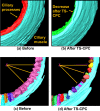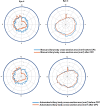Deep Learning Segmentation, Visualization, and Automated 3D Assessment of Ciliary Body in 3D Ultrasound Biomicroscopy Images
- PMID: 36180029
- PMCID: PMC9547360
- DOI: 10.1167/tvst.11.10.3
Deep Learning Segmentation, Visualization, and Automated 3D Assessment of Ciliary Body in 3D Ultrasound Biomicroscopy Images
Abstract
Purpose: This study aimed to develop a fully automated deep learning ciliary body segmentation and assessment approach in three-dimensional ultrasound biomicroscopy (3D-UBM) images.
Methods: Each 3D-UBM eye volume was aligned to the optic axis via multiplanar reformatting. Ciliary muscle and processes were manually annotated, and Deeplab-v3+ models with different loss functions were trained to segment the ciliary body (ciliary muscle and processes) in both en face and radial images.
Results: We trained and tested the models on 4320 radial and 3864 en face images from 12 cadaver eye volumes. Deep learning models trained on radial images with Dice loss achieved the highest mean F1-score (0.89) for ciliary body segmentation. For three-class segmentation (ciliary muscle, processes, and background), radial images with Dice loss achieved the highest mean F1-score (0.75 for the ciliary process and 0.82 for the ciliary muscle). Part of the ciliary muscle (10.9%) was misclassified as the ciliary process and vice versa, which occurred owing to the difficulty in differentiating the ciliary muscle-processes border, even by experts. Deep learning segmentation made further editing by experts at least seven times faster than a fully manual approach. In eight cadaver eyes, the average ciliary muscle, process, and body volumes were 56 ± 9, 43 ± 13, and 99 ± 18 mm3, respectively. The average surface area of the ciliary muscle, process, and body were 346 ± 45, 363 ± 83, and 709 ± 80 mm2, respectively. We performed transscleral cyclophotocoagulation in cadaver eyes to shrink the ciliary processes. Both manual and automated measurements from deep learning segmentation show a decrease in volume, surface area, and 360° cross-sectional area measurements.
Conclusions: The proposed deep learning segmentation of the ciliary body and 3D measurements showed transscleral cyclophotocoagulation-related changes in the ciliary body.
Translational relevance: Automated ciliary body assessment using 3D-UBM has the translational potential for ophthalmic treatment planning and monitoring.
Conflict of interest statement
Disclosure:
Figures









References
-
- Cook C, Foster P. Epidemiology of glaucoma: what's new? Can J Ophthalmol. 2012; 47(3): 223–226. - PubMed
-
- Prata TS, Dorairaj S, De Moraes CG, et al. . Is preoperative ciliary body and iris anatomical configuration a predictor of malignant glaucoma development?: Prediction of malignant glaucoma. Clin Exp Ophthalmol. 2013; 41(6): 541–545. - PubMed
-
- Ku JY, Nongpiur ME, Park J, et al. .. Qualitative evaluation of the iris and ciliary body by ultrasound biomicroscopy in subjects with angle closure. J Glaucoma. 2014; 23(9): 583–588. - PubMed
-
- Wang Z, Huang J, Lin J, Liang X, Cai X, Ge J. Quantitative measurements of the ciliary body in eyes with malignant glaucoma after trabeculectomy using ultrasound biomicroscopy. Ophthalmology. 2014; 121(4): 862–869. - PubMed
-
- Ben-Zion I, Tomkins O, Moore DB, Helveston EM. Surgical results in the management of advanced primary congenital glaucoma in a rural pediatric population. Ophthalmology. 2011; 118(2): 231–235.e1. - PubMed
Publication types
MeSH terms
Grants and funding
LinkOut - more resources
Full Text Sources
Research Materials

